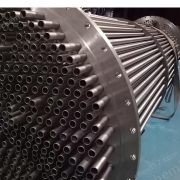Why Cold-Drawn Seamless Tubes Are Used in Boilers and Heat Exchangers?
Introduction
Boilers and heat exchangers play critical roles in efficiently transferring heat in industries like power generation, chemical processing, and oil refining. The performance, reliability, and lifespan of these components heavily depend on the materials’ quality. One material that consistently stands out is cold-drawn seamless tubes. This blog will explain why these tubes are preferred in such demanding applications, focusing on their properties, advantages, and how they address common concerns in boiler and heat exchanger systems.
1. Understanding Cold-Drawn Seamless Tubes
Cold-drawn seamless tubes are produced through a multi-step process that involves drawing a solid billet over a mandrel to create a hollow tube. Unlike welded tubes, they have no welded joints, resulting in a uniform structure with superior mechanical properties. The term “cold-drawn” refers to reducing the tube diameter and thickness at room temperature, enhancing its strength and surface finish.
Characteristics:
- Seamless Construction: No welds or joints that can become points of failure.
- Cold Drawing Process: Improves mechanical properties and surface quality.
- Customizable Dimensions: High precision in wall thickness, diameter, and length.
2. Why Cold-Drawn Seamless Tubes Are Preferred in Boilers
Boilers operate under extreme temperature and pressure conditions, demanding materials that can endure thermal stress, corrosion, and erosion. Cold-drawn seamless tubes offer several advantages that make them well-suited for these environments:
2.1. Superior Strength
The cold-drawing process increases the tubes’ tensile strength and hardness, making them more resistant to deformation under high pressure. This is especially crucial in boilers, where tubes must maintain structural integrity despite fluctuating internal pressures.
2.2. High Resistance to Thermal Stress
Boilers undergo rapid heating and cooling cycles, which induce thermal stress in the tubes. Cold-drawn seamless tubes have a homogenous microstructure, ensuring even heat distribution and minimizing the risk of cracks or failure due to thermal fatigue.
2.3. Corrosion Resistance
Water and steam can cause corrosion in boilers, leading to leaks and reduced efficiency. Many cold-drawn seamless tubes are made from corrosion-resistant alloys, such as stainless steel or high-temperature nickel alloys, which can withstand corrosive environments in power plants and industrial boilers.
2.4. Improved Longevity
Seamless tubes have fewer defects like inclusions or impurities that can weaken the material over time. This translates to longer service life and less downtime for repairs, improving the overall operational efficiency of boiler systems.
3. The Role of Cold-Drawn Seamless Tubes in Heat Exchangers
Heat exchangers transfer heat between fluids without direct contact between them. Tubes in heat exchangers must provide efficient thermal conductivity, withstand high-pressure environments, and resist corrosion.
3.1. Thermal Conductivity
Cold-drawn seamless tubes often feature a smooth and uniform surface, which improves heat transfer efficiency. In applications like steam condensers and shell-and-tube heat exchangers, the enhanced surface finish reduces the buildup of deposits, ensuring optimal heat exchange.
3.2. Precision in Dimensions
Heat exchangers require tubes with precise wall thickness and diameter tolerances to maintain efficient fluid flow and heat transfer. The cold-drawing process offers high dimensional accuracy, ensuring that tubes fit tightly within the exchanger without any gaps that could reduce efficiency.
3.3. Resistance to Fouling and Scaling
Cold-drawn seamless tubes, particularly those made from high-alloy materials like stainless steel, resist fouling and scaling—common problems that reduce the efficiency of heat exchangers. The smoother surfaces created by the cold-drawing process also reduce the adhesion of particles and scale, allowing for easier maintenance and cleaning.
3.4. Durability Under Cyclical Loading
Heat exchangers are often subjected to cyclical pressure variations. Cold-drawn seamless tubes are better equipped to handle these conditions due to their higher yield strength and better fatigue resistance, ensuring fewer tube failures.
4. Addressing Common Concerns with Cold-Drawn Seamless Tubes
Given their critical role in high-performance systems, it’s natural for users to be concerned about cold-drawn seamless tubes’ performance and reliability. Below are some solutions and guidelines for common issues.
4.1. Concern: Material Selection
Selecting a suitable material is crucial for performance in boilers and heat exchangers. Stainless steels, carbon steels, and nickel alloys are commonly used for cold-drawn seamless tubes. Stainless steel (e.g., SS 316) provides excellent corrosion resistance for corrosive environments. Nickel-based alloys (e.g., Inconel) are often preferred in high-temperature applications.
4.2. Concern: Tube Failure Due to Corrosion
Although cold-drawn seamless tubes resist corrosion, specific environments—like those containing chlorides—can still cause localized corrosion. Solutions include selecting the appropriate alloy and applying protective coatings when necessary. Regular inspection and maintenance are also critical for detecting early signs of corrosion.
4.3. Concern: Operational Downtime
For industries like power generation, tube replacement or repair downtime can be costly. Cold-drawn seamless tubes reduce the need for frequent maintenance due to their higher durability and resistance to common wear mechanisms like corrosion and erosion, minimizing overall operational downtime.
4.4. Concern: Cost Efficiency
While cold-drawn seamless tubes may have a higher initial cost than welded alternatives, their longer service life, improved reliability, and reduced maintenance needs result in lower overall lifecycle costs. When evaluating long-term operational expenses, the use of seamless tubes often proves to be more cost-effective.
5. Conclusion
Cold-drawn seamless tubes provide an unmatched combination of strength, thermal resistance, and corrosion protection, making them an ideal choice for boilers and heat exchangers in various industries. Their superior mechanical properties, high precision, and durability ensure they can withstand these systems’ demanding conditions, improving efficiency and reducing maintenance needs.
By investing in cold-drawn seamless tubes, industries can achieve excellent operational reliability and extend the service life of their critical equipment, ultimately leading to reduced costs and better performance over time. Whether you are designing a boiler or heat exchanger system, selecting cold-drawn seamless tubes is a strategic decision that will pay dividends in both performance and longevity.


